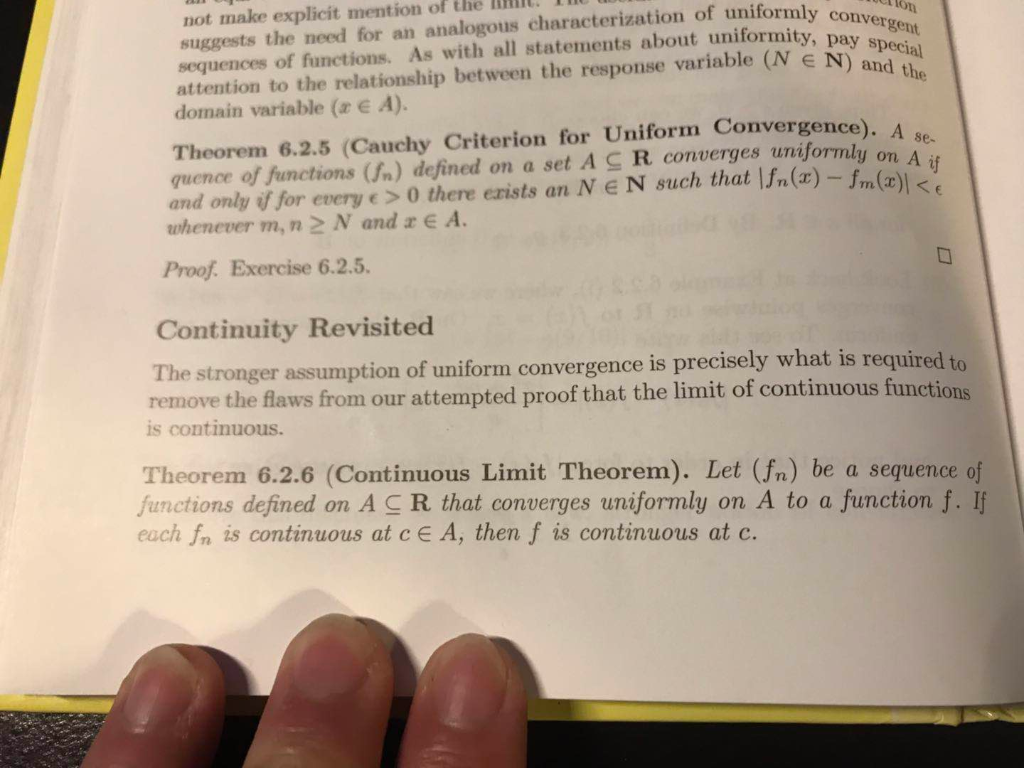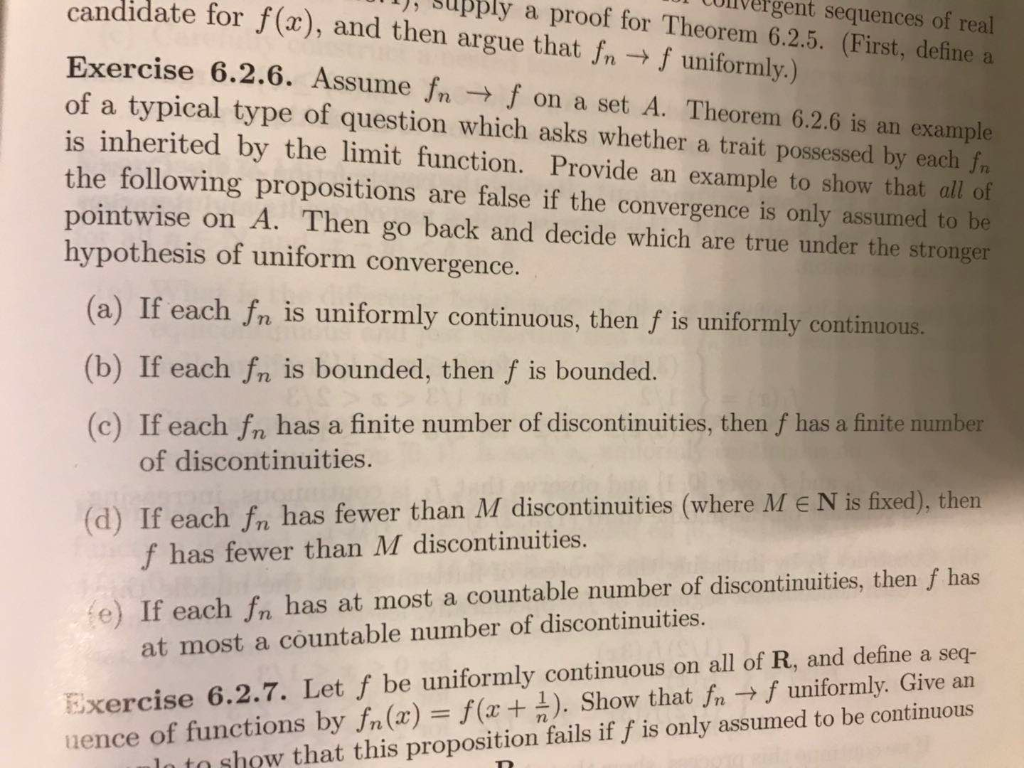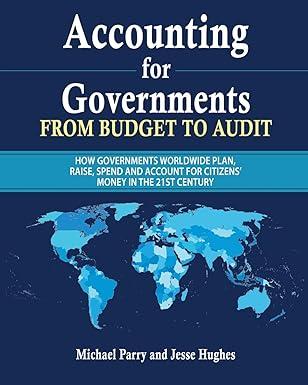Answered step by step
Verified Expert Solution
Question
1 Approved Answer
Please help me do last 4 parts about 6.2.6 not make explicit mention of the onv suggests the need for an analogous characterization of uniformly


Please help me do last 4 parts about 6.2.6
not make explicit mention of the onv suggests the need for an analogous characterization of uniformly sequences of functions. As with all statements about uniformity, pay nt N) and cia atention to the relationship between the response variable (V domain variable (a e A). Theorem 6.2.5 (Cauchy Criterion for Uniform Convergence). A quence of functions (Jn) defined on a set A C R converges uniformly on 4 and only if for every e >0 there erists an N e N such that n (x) Im(z) whenever m, n 2 N and r E A. Proof. Exercise 6.2.5. Continuity Revisited The stronger assumption of uniform convergence is precisely what is required t remove the flaws from our attempted proof that the limit of continuous functio is continuous. ns Theorem 6.2.6 (Continuous Limit Theorem). Let (fn) be a sequence of junctions defined on AC R that converges uniformly on A to a function f. If each fn is continuous at cE A, then f is continuous at c. candidate for f(x), and then argue that fnf uniformly.) 1), Supply a tolivergent sequences proof for Theorem 6.2.5. (First, define a Exercise 6.2.6. Assume fn f on a set A. Theorem 6.2.6 is an example of a typical type of question which asks whether a trait possessed by each f is inherited by the limit function. Provide an example to show that all of the following propositions are false if the convergence is only assumed to be pointwise on A. Then go back and decide which are true under the stronger of real hypothesis of uniform convergence. (a) If each fn is uniformly continuous, then f is uniformly continuous (b) If each fn is bounded, then f is bounded. (c) If each fn has a finite number of discontinuities, then f has a finite number of discontinuities. (d) If each fn has fewer than M discontinuities (where M E N is fixed), then f has fewer than M discontinuities. e) If each fn has at most a countable number of discontinuities, then f has at most a countable number of discontinuities. Exercise 6.2.7. Let f be uniformly continuous on all of R, and define a seq- f(z+ 1). Show that fn uence of functions by fn(x) Io to show that this proposition fails if f is only assumed to be continuous not make explicit mention of the onv suggests the need for an analogous characterization of uniformly sequences of functions. As with all statements about uniformity, pay nt N) and cia atention to the relationship between the response variable (V domain variable (a e A). Theorem 6.2.5 (Cauchy Criterion for Uniform Convergence). A quence of functions (Jn) defined on a set A C R converges uniformly on 4 and only if for every e >0 there erists an N e N such that n (x) Im(z) whenever m, n 2 N and r E A. Proof. Exercise 6.2.5. Continuity Revisited The stronger assumption of uniform convergence is precisely what is required t remove the flaws from our attempted proof that the limit of continuous functio is continuous. ns Theorem 6.2.6 (Continuous Limit Theorem). Let (fn) be a sequence of junctions defined on AC R that converges uniformly on A to a function f. If each fn is continuous at cE A, then f is continuous at c. candidate for f(x), and then argue that fnf uniformly.) 1), Supply a tolivergent sequences proof for Theorem 6.2.5. (First, define a Exercise 6.2.6. Assume fn f on a set A. Theorem 6.2.6 is an example of a typical type of question which asks whether a trait possessed by each f is inherited by the limit function. Provide an example to show that all of the following propositions are false if the convergence is only assumed to be pointwise on A. Then go back and decide which are true under the stronger of real hypothesis of uniform convergence. (a) If each fn is uniformly continuous, then f is uniformly continuous (b) If each fn is bounded, then f is bounded. (c) If each fn has a finite number of discontinuities, then f has a finite number of discontinuities. (d) If each fn has fewer than M discontinuities (where M E N is fixed), then f has fewer than M discontinuities. e) If each fn has at most a countable number of discontinuities, then f has at most a countable number of discontinuities. Exercise 6.2.7. Let f be uniformly continuous on all of R, and define a seq- f(z+ 1). Show that fn uence of functions by fn(x) Io to show that this proposition fails if f is only assumed to be continuousStep by Step Solution
There are 3 Steps involved in it
Step: 1

Get Instant Access to Expert-Tailored Solutions
See step-by-step solutions with expert insights and AI powered tools for academic success
Step: 2

Step: 3

Ace Your Homework with AI
Get the answers you need in no time with our AI-driven, step-by-step assistance
Get Started


